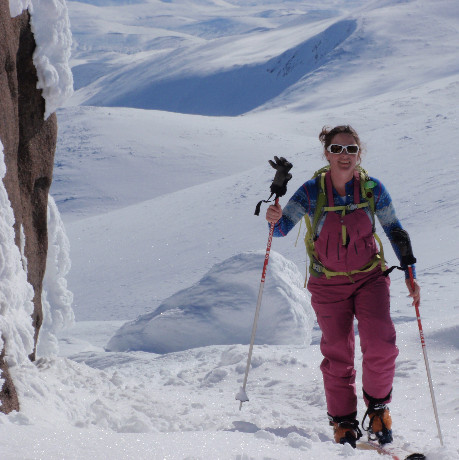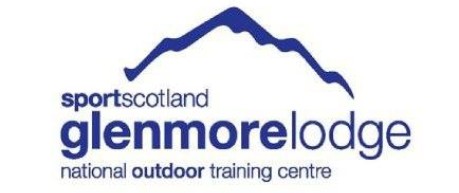by Ian Sherrington (IFMGA Guide & Chief Instructor at Glenmore Lodge)
Snow sports touring: it’s the most complete and satisfying way to travel in the mountains.
You still earn your turns, needing hill fitness to help you glide your skis or split boards to the more remote summits. You also need all the skill of the winter mountaineer. The Scottish mountains in winter can be wild and we need to be able to navigate, avoid avalanche, and survive.
For hardy tourers these challenges just add to the satisfaction, knowing they have used their skill and guile to engineer a great day out. The reward for their efforts hopefully being stunning views and the thrill of making first tracks in a remote amphitheatre.

Skiing on Beinn Mheadhoinn. Photo by Heather Morning
The trick is to go with a competent team who can introduce you progressively and within your capabilities. For those who are not mountaineers, you should go with those who are: friends, courses or clubs who can help make your first experience one that’ll have you hooked for life.
Skiers should have equipment adapted to meet the needs of both winter walking and skiing. Our boots are like a downhill ski boot, but with a mountain boot sole, and the ability to be made flexible for walking.
To walk uphill our ski binding has the ability to release at the heel and flex at the toe. We apply a re-usable skin to the ski, which slides forward but not backwards. Then we’re off, leaving tramlines up the hill and gliding close to the surface where walkers are wading through deep hollows.
When we get to the summit we remove the skins, lock down the heel of the binding, tighten up our boots and we’re in ski mode again.
Boarders usually walk, with or without snow shoes, and carry their boards, but there are a number of variations. This means they have the limitations of the footwear they ride in. So for those going into more icy, steep terrain they will often ride in hard boots or boots very similar to ski mountaineering boots so that they too can have a Vibram sole and the ability to wear crampons.
For uphill travel some prefer to use short skis with a skin attached – they can be stashed in the pack for riding – while others prefer a ‘split board’, which comes in half along its length and can be used like a touring ski for walking uphill.
A number of well-known folk in the sport were self-taught, and survived the process. However, there are negatives with this approach.
The first is just how quickly it is possible to get into a very serious situation, particularly sliding downhill on snow. Fun turns and a little speed are so addictive that you can easily find yourself misplaced in the mist.
The second issue is one of learning in isolation. It is very special to feel part of a select group of folk doing their thing in the mountains, but learning from books and DVDs can be a long slow process.
Joining clubs or organised courses makes much more sense. I work at Glenmore Lodge, the Scottish National Outdoor Training Centre, and we offer a range of ski mountaineering courses, from introductory level through to advanced and abroad.
If you are concerned about your ski ability and how well you will adapt to the off-piste, then you might consider a few lessons. Most ski schools will have instructors who love to ski off piste. They can help you try it out without having to carry a rucksack. Your progression will be a lot quicker and more positive.
You will also get good advice on equipment from your local retailers. Ours is a small sport so seek out the specialists for good advice.
In these videos Glenmore Lodge instructor Andy Townsend runs through some of the key considerations when buying skis and bindings for ski touring.

There is a strong tradition of skiing at Glenmore Lodge, which offers a range of courses in ski-touring and off piste skiing, from introductory to advanced level.